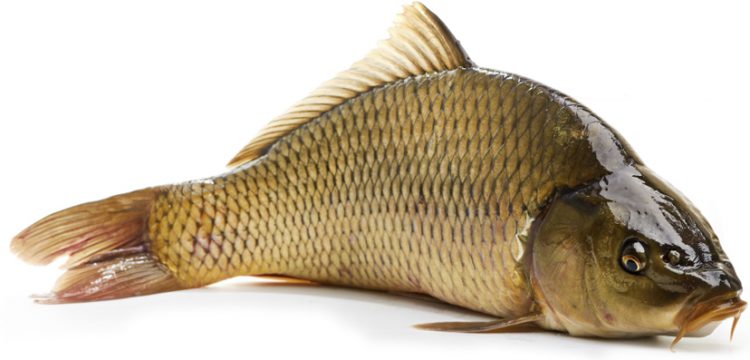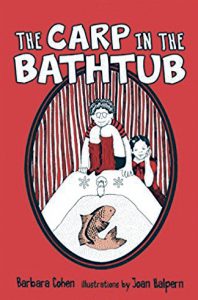Remembering that carp in my grandparents’ bathtub

By Lynne Daroff Foosaner, JTA
My grandmother was a super shopper even before the advent of supermarkets and coupons. In those days, each food group had its own store, and every neighborhood had a butcher shop, fish market, dairy, deli and grocery.
Shopping with Grandma was an all-day experience. Time stood still as she filled her cart with the biggest, the fattest, the freshest, the juiciest of foods.
Her culinary talents were legendary; the local shopkeepers greeted her by name and brought out their finest products for her inspection. Grandma, trained as a professional chef in the old country, ratcheted into high gear during holiday seasons, especially Passover.
Passover brought us to the most exciting adventure of all: the fish market.
The fish market was a hoot. In those days, fish wasn’t displayed in a refrigerated case, packed in ice or neatly shrink-wrapped. Nor was it available as little sticks or cakes, all filleted, breaded, seasoned and boxed in the freezer section.
No, in the days when fresh meant alive, fish swam freely in long wooden troughs outfitted with rubber hoses to bubble and circulate the water. The general wetness of the environment was augmented by thrashing, splashing fish.
Grandma always tried to restrain me, but my curiosity and perseverance won every time.
While she sized up the creatures, I stood on a wooden bench and hung over the edge of the trough, leaning into the swirling mass of cold-blooded vertebrates, hands extended, trying to capture myself a pet.
In honor of Passover, the fishery annually brought in unusually large stocks of huge, fierce-looking carp that flopped about wildly.
Grandma, in respectful awe of the sizable beasts, insisted I wait just at the edge of the puddle-soaked floor while she sidled into the sea of kerchiefed women who shouted, jabbered and pointed out fish to the workers.
Once she turned her attention to the task at hand, however, I always managed to wiggle through the crowd and take my place on the wooden bench.
I watched Grandma’s intense concentration, amazed that she could select exactly which fish she wanted. The hapless carp was captured, tagged, and then delivered alive to Grandma’s house, where it swam freely in the bathtub for one day.
I would drive Grandma crazy visiting it. Ignoring Grandma’s pleas not to get too friendly with the fish, I would name it, then lean over the rim of the bathtub, and get soaked trying to pet it.
 The following morning the household rose especially early. It was the day of the first Seder and there were endless chores to finish and mountains of food to prepare.
The following morning the household rose especially early. It was the day of the first Seder and there were endless chores to finish and mountains of food to prepare.
That’s when my Grandpa grimly appeared at the bathroom door, surveyed the situation and wrestled that fish into a waiting towel.
It squirmed and thrashed in Grandpa’s arms. Naughty words sprang from Grandpa’s mouth, in English, Yiddish, Hungarian, Russian and Polish — he was a multilingual curser!
In a desperate last thrust for freedom, the fish flew out of Grandpa’s arms and onto the floor.
Grandpa began to sweat profusely before he finally managed to half-drag, half-push it across the floor into the kitchen.
Unfortunately, it was also Grandpa’s job to hasten the fish to its greater reward in heaven. Grandma stood by, waving a dish towel, criticizing, suggesting, directing — but mostly crying for the fish’s imminent death, even though it was the natural order of things for carp to be transformed into gefilte fish patties.
Grandma, with a soft heart for all living creatures, often passed up eating her own homemade gefilte fish. I, on the other hand, had no difficulty gobbling up my previous one-day pet.
As the years passed, the Passover carp scenario played out over and over. Supermarkets eventually supplanted the fishery and all the mom-and-pop stores.
Live food disappeared from view, except for the occasional lobster, replaced with prepackaged and sanitized choices.
My mother did not follow in Grandma’s footsteps. Mother would not play hostess and executioner to a live fish, even if it meant no gefilte fish for Passover.
But fortunately for Mother, by the time she assumed the mantle of matriarch, gefilte fish was available ready to eat from jars and cans.
Mother created a new Passover tradition in our family. My children’s memories consist of watching their grandmother wrestle blobs of gefilte fish out of a jar, wipe off the weird jelly stuff, and plop the patties onto a waiting platter of lettuce.
Today, with my Grandma and Mother both gone, I’m the new matriarch and a grandmother, too. It is my responsibility and joy to prepare the Passover table.
But even with all the modern conveniences and choices available to me, visions of my Grandma and our carp-drenched bathroom fill my heart, to say nothing of the melt-in-your-mouth fish made tastier by the added ingredient of Grandma’s love.
To me, Passover is gefilte fish. No grandchild of mine should eat an assembly-line appetizer from a jar like my mother served.
No, my grandchildren deserve old-fashioned, handmade food. So I plan to have the entire meal catered.
Lynne Daroff Foosaner is a freelance writer, political activist, artist and grandmother, not necessarily in that order.
To read the complete March 2018 Dayton Jewish Observer, click here.

